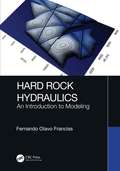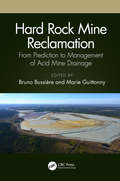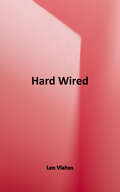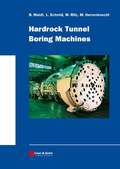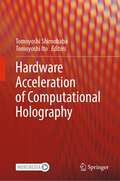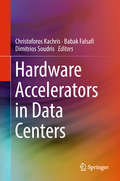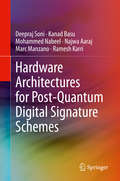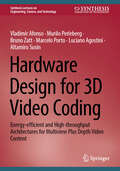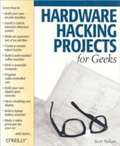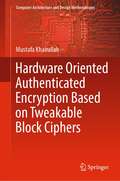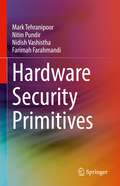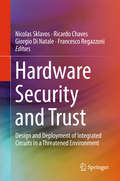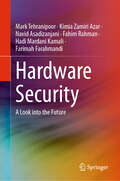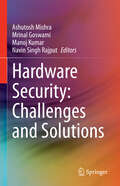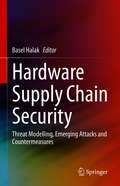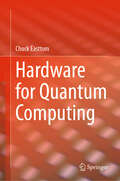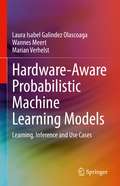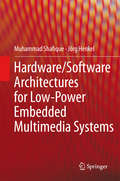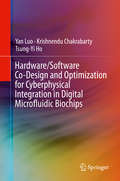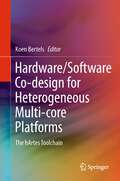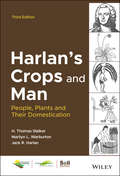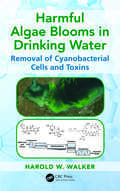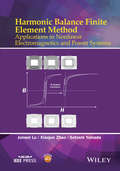- Table View
- List View
Hard Rock Hydraulics: An Introduction to Modeling
by Fernando Olavo FrancissHard rock hydraulics concerns arrangements of adjoining intact rock blocks, occurring down to a depth of hundreds of meters, where groundwater percolates within the gaps between these blocks. During the last decades, technical papers related to successful or failed attempts for mining groundwater from hard rocks, and achievements or failures of public or mining developments with respect to these rocks, increased the knowledge of their hydraulics. Examples of activities where the mechanical behavior of these rocks highly interacts with their hydraulics are projects under the sea or groundwater level, such as open pits or underground mines, galleries, tunnels, shafts, underground hydropower plants, oil and LPG storage caverns, and deep disposal of hazardous waste. This book dedicated to hard rock hydraulics assumes some prior knowledge of hydraulics, geology, hydrogeology, and soil and rock mechanics. Chapter I discusses the main issues of modeling; chapter II covers the fundamentals of hard rock hydraulics; chapter III presents concepts regarding approximate solutions; chapter IV discusses data analysis for groundwater modeling; chapter V focuses on finite differences and chapter VI provides examples of some particular unusual applications. This book will help civil and mining engineers and also geologists to solve their practical problems in hydrogeology and public or mining projects.
Hard Rock Mine Reclamation: From Prediction to Management of Acid Mine Drainage
by Bruno Bussière Marie GuittonnyHard rock mines have significant effects on the territories where they operate, through both infrastructure construction as well as resource use. Due to their extractive activities, these mines store large quantities of wastes at the surface, which can be both physically and chemically unstable. Reclamation aims to return a mine site to a satisfactory state, meaning that the site should not threaten human health or security, should not generate in the long term any contaminant that could significantly affect the surrounding environment, and should be aesthetically acceptable to communities. This book focuses on the reclamation of waste storage areas, which constitute the main source of pollution during and after mine operations, and especially issues with acid mine drainage and neutral contaminated drainage. Features: Provides fundamental information and describes practical methods to reclaim mine-waste facilities Compares the different methods and illustrates their application at sites through case studies Identifies new reclamation issues and proposes solutions to address them Presents existing and new technologies to reclaim mine waste disposal areas from hard rock mines in different climatic conditions Integrates reclamation into mine operations and long term performance of techniques used through an interdisciplinary approach With mine site reclamation a young and still emerging science, the training needs for professionals and students working in this field are huge. This book is written from an engineering point of view and in it the authors identify new reclamation issues and propose well-tested as well as innovative approaches to addressing them. Students in graduate programs focused on mines and the environment as well as professionals already working in departments related to mine site reclamation will find this book to be a valuable and essential resource.
Hard Wired
by Len VlahosAfter fifteen-year-old Quinn learns that he is the first fully aware artificial intelligence, that his entire life is a lie, he feels entirely alone until he bonds with Shea, the real girl behind his virtual crush.
Hardrock Tunnel Boring Machines
by Willy Ritz Leonhard Schmid Martin Herrenknecht Bernhard MaidlThis book covers the fundamentals of tunneling machine technology: drilling, tunneling, waste removal and securing. It treats methods of rock classification for the machinery concerned as well as legal issues, using numerous example projects to reflect the state of technology, as well as problematic cases and solutions. The work is structured such that readers are led from the basics via the main functional elements of tunneling machinery to the different types of machine, together with their areas of application and equipment. The result is an overview of current developments. Close cooperation among the authors involved has created a book of equal interest to experienced tunnelers and newcomers.
Hardware Acceleration of Computational Holography
by Tomoyoshi Shimobaba Tomoyoshi ItoThis book explains the hardware implementation of computational holography and hardware acceleration techniques, along with a number ofconcrete example source codes that enable fast computation. Computational holography includes computer-based holographictechnologies such as computer-generated hologram and digital holography, for which acceleration of wave-optics computation is highly desirable.This book describes hardware implementations on CPUs (Central Processing Units), GPUs (Graphics Processing Units) and FPGAs (Field ProgrammableGate Arrays).This book is intended for readers involved in holography as well as anyone interested in hardware acceleration.
Hardware Accelerators in Data Centers
by Dimitrios Soudris Christoforos Kachris Babak FalsafiThis book provides readers with an overview of the architectures, programming frameworks, and hardware accelerators for typical cloud computing applications in data centers. The authors present the most recent and promising solutions, using hardware accelerators to provide high throughput, reduced latency and higher energy efficiency compared to current servers based on commodity processors. Readers will benefit from state-of-the-art information regarding application requirements in contemporary data centers, computational complexity of typical tasks in cloud computing, and a programming framework for the efficient utilization of the hardware accelerators.
Hardware Architectures for Post-Quantum Digital Signature Schemes
by Ramesh Karri Deepraj Soni Kanad Basu Mohammed Nabeel Najwa Aaraj Marc ManzanoThis book explores C-based design, implementation, and analysis of post-quantum cryptography (PQC) algorithms for signature generation and verification. The authors investigate NIST round 2 PQC algorithms for signature generation and signature verification from a hardware implementation perspective, especially focusing on C-based design, power-performance-area-security (PPAS) trade-offs and design flows targeting FPGAs and ASICs.Describes a comprehensive set of synthesizable c code base as well as the hardware implementations for the different types of PQC algorithms including lattice-based, code-based, and multivariate-based;Demonstrates the hardware (FPGA and ASIC) and hardware-software optimizations and trade-offs of the NIST round 2 signature-based PQC algorithms;Enables designers to build hardware implementations that are resilient to a variety of side-channels.
Hardware Design for 3D Video Coding: Energy-efficient and High-throughput Architectures for Multiview Plus Depth Video Content (Synthesis Lectures on Engineering, Science, and Technology)
by Bruno Zatt Luciano Agostini Vladimir Afonso Murilo Perleberg Marcelo Porto Altamiro SusinThis book focuses on the research and development challenges posed by 3D video systems based on multi-view plus depth (MVD) technology. This technology can produce a realistic immersive experience generating synthetic video views on the decoder side, reducing the amount of information on the encoder side. The discussion presented in this book explores the MVD characteristics to propose high-throughput and energy-efficient architectures/systems, focusing on 3D-HEVC, the state-of-the-art standard for exploiting the MVD concept. The book includes an extensive discussion of the 3D-HEVC video encoding, followed by an in-depth evaluation of the 3D-HEVC reference software behavior. Then, the book presents in detail a set of high-throughput and energy-efficient architectures targeting the three main prediction steps inside the 3D-HEVC: intra-frame prediction, inter-frame prediction, and inter-view prediction.
Hardware Hacking Projects for Geeks
by Scott FullamPut a hacker in a room with a Furby for a weekend and you'll hear a conversation that's fairly one-sided in its originality. Toss in an 802.11b network card, a soldering iron, wire cutters, a logic probe, and a few other carefully selected tools and materials and you'll have potential. Add a copy of Hardware Hacking Projects for Geeks and by the end of the weekend that Furby will be saying things you never imagined. From building an Internet toaster to creating a cubicle intrusion detection system, Hardware Hacking Projects for Geeks offers an array of inventive, customized electronics projects for the geek who can't help looking at a gadget and wondering how it might be "upgraded." Beginning with basic hacks, tools, and techniques for those who may not have a background in electronics, the book covers the tools of the hardware hacking trade and basic soldering techniques, then moves into more advanced hacking projects. Clear step-by-step instructions allow even those with no formal electronics- or hardware-engineering skills to hack real hardware in very clever ways. Hacks in the book are rated on a scale of difficulty, cost, and duration. Projects range from those that are truly useful to some things you may have never thought to do, but which are really cool, such as: Building your own arcade game Making radio-controlled cars play laser tag Building an automobile periscope Hacking an 802.11b antenna Building a building size display Perhaps you're an electronics hobbyist who likes to learn by doing. Maybe you hack software and want to see how the other half lives. Or, maybe you've never hacked at all, but you'd like to get started quickly with some projects that do something interesting from the start. If you're any of these, then Hardware Hacking Projects for Geeks will indulge your inner mad scientist. Using the projects in this book as a jumping point for other new and clever hacks, it won't be long before you're looking around, asking, "I wonder what I can improve next?"
Hardware Oriented Authenticated Encryption Based on Tweakable Block Ciphers (Computer Architecture and Design Methodologies)
by Mustafa KhairallahThis book presents the use of tweakable block ciphers for lightweight authenticated encryption, especially applications targeted toward hardware acceleration where such efficient schemes have demonstrated competitive performance and strong provable security with large margins. The first part of the book describes and analyzes the hardware implementation aspects of state-of-the-art tweakable block cipher-based mode ΘCB3. With this approach, a framework for studying a class of tweakable block cipher-based schemes is developed and two family of authenticated encryption algorithms are designed for the lightweight standardization project initiated by the National Institute of Standards and Technology (NIST): Romulus and Remus. The Romulus family is a finalist for standardization and targets a wide range of applications and performance trade-offs which will prove interesting to engineers, hardware designers, and students who work in symmetric key cryptography.
Hardware Security Primitives
by Mark Tehranipoor Farimah Farahmandi Nitin Pundir Nidish VashisthaThis book provides an overview of current hardware security primitives, their design considerations, and applications. The authors provide a comprehensive introduction to a broad spectrum (digital and analog) of hardware security primitives and their applications for securing modern devices. Readers will be enabled to understand the various methods for exploiting intrinsic manufacturing and temporal variations in silicon devices to create strong security primitives and solutions. This book will benefit SoC designers and researchers in designing secure, reliable, and trustworthy hardware.Provides guidance and security engineers for protecting their hardware designs;Covers a variety digital and analog hardware security primitives and applications for securing modern devices;Helps readers understand PUF, TRNGs, silicon odometer, and cryptographic hardware design for system security.
Hardware Security Training, Hands-on!
by Mark Tehranipoor Farimah Farahmandi N. Nalla AnandakumarThis is the first book dedicated to hands-on hardware security training. It includes a number of modules to demonstrate attacks on hardware devices and to assess the efficacy of the countermeasure techniques. This book aims to provide a holistic hands-on training to upper-level undergraduate engineering students, graduate students, security researchers, practitioners, and industry professionals, including design engineers, security engineers, system architects, and chief security officers. All the hands-on experiments presented in this book can be implemented on readily available Field Programmable Gate Array (FPGA) development boards, making it easy for academic and industry professionals to replicate the modules at low cost. This book enables readers to gain experiences on side-channel attacks, fault-injection attacks, optical probing attack, PUF, TRNGs, odometer, hardware Trojan insertion and detection, logic locking insertion and assessment, and more.
Hardware Security and Trust
by Nicolas Sklavos Ricardo Chaves Giorgio Natale Francesco RegazzoniThis book provides a comprehensive introduction to hardware security, from specification to implementation. Applications discussed include embedded systems ranging from small RFID tags to satellites orbiting the earth. The authors describe a design and synthesis flow, which will transform a given circuit into a secure design incorporating counter-measures against fault attacks. In order to address the conflict between testability and security, the authors describe innovative design-for-testability (DFT) computer-aided design (CAD) tools that support security challenges, engineered for compliance with existing, commercial tools. Secure protocols are discussed, which protect access to necessary test infrastructures and enable the design of secure access controllers.
Hardware Security: A Look into the Future
by Mark Tehranipoor Farimah Farahmandi Navid Asadizanjani Kimia Zamiri Azar Hadi Mardani Kamali Fahim RahmanThis book provides a look into the future of hardware and microelectronics security, with an emphasis on potential directions in security-aware design, security verification and validation, building trusted execution environments, and physical assurance. The book emphasizes some critical questions that must be answered in the domain of hardware and microelectronics security in the next 5-10 years: (i) The notion of security must be migrated from IP-level to system-level; (ii) What would be the future of IP and IC protection against emerging threats; (iii) How security solutions could be migrated/expanded from SoC-level to SiP-level; (iv) the advances in power side-channel analysis with emphasis on post-quantum cryptography algorithms; (v) how to enable digital twin for secure semiconductor lifecycle management; and (vi) how physical assurance will look like with considerations of emerging technologies. The main aim of this book is to serve as a comprehensive and concise roadmap for new learners and educators navigating the evolving research directions in the domain of hardware and microelectronic securities. Overall, throughout 11 chapters, the book provides numerous frameworks, countermeasures, security evaluations, and roadmaps for the future of hardware security.
Hardware Security: Challenges and Solutions
by Manoj Kumar Ashutosh Mishra Navin Singh Rajput Mrinal GoswamiThis book provides a comprehensive overview of hardware security challenges and solutions, making it an essential resource for engineers, researchers, and students in the field. The authors cover a wide range of topics, from hardware design and implementation to attack models and countermeasures. They delve into the latest research and industry practices in the field, including techniques for secure chip design, hardware Trojan detection, side-channel attack mitigation, the threats and vulnerabilities facing modern hardware, the design and implementation of secure hardware, and the latest techniques for testing and verifying the security of hardware systems. The book also covers emerging technologies such as quantum computing and the Internet of Things, and their impact on hardware security. With its practical approach and extensive coverage of the subject, this book is an ideal reference for anyone working in the hardware security industry.
Hardware Supply Chain Security: Threat Modelling, Emerging Attacks and Countermeasures
by Basel HalakThis book presents a new threat modelling approach that specifically targets the hardware supply chain, covering security risks throughout the lifecycle of an electronic system. The authors present a case study on a new type of security attack, which combines two forms of attack mechanisms from two different stages of the IC supply chain. More specifically, this attack targets the newly developed, light cipher (Ascon) and demonstrates how it can be broken easily, when its implementation is compromised with a hardware Trojan. This book also discusses emerging countermeasures, including anti-counterfeit design techniques for resources constrained devices and anomaly detection methods for embedded systems.
Hardware for Quantum Computing
by Chuck EasttomThis book covers extensively the physical implementation of qubits and quantum architecture. The author demonstrates how quantum computing is implemented by the underlying physical implementation of qubits, including trapped ions, nitrogen vacancy centers, frozen neon, and other implementations. The book shows how, ultimately, the physical implementation of the qubit is the foundation of quantum computing, and that the choice of physical qubit will impact such things as decoherence times, computational efficiency, and even error rate. The book explores all the current approaches to physical qubit implementation and includes appendices that review basic quantum computing and physics.
Hardware-Aware Probabilistic Machine Learning Models: Learning, Inference and Use Cases
by Marian Verhelst Wannes Meert Laura Isabel Galindez OlascoagaThis book proposes probabilistic machine learning models that represent the hardware properties of the device hosting them. These models can be used to evaluate the impact that a specific device configuration may have on resource consumption and performance of the machine learning task, with the overarching goal of balancing the two optimally. The book first motivates extreme-edge computing in the context of the Internet of Things (IoT) paradigm. Then, it briefly reviews the steps involved in the execution of a machine learning task and identifies the implications associated with implementing this type of workload in resource-constrained devices. The core of this book focuses on augmenting and exploiting the properties of Bayesian Networks and Probabilistic Circuits in order to endow them with hardware-awareness. The proposed models can encode the properties of various device sub-systems that are typically not considered by other resource-aware strategies, bringing about resource-saving opportunities that traditional approaches fail to uncover. The performance of the proposed models and strategies is empirically evaluated for several use cases. All of the considered examples show the potential of attaining significant resource-saving opportunities with minimal accuracy losses at application time. Overall, this book constitutes a novel approach to hardware-algorithm co-optimization that further bridges the fields of Machine Learning and Electrical Engineering.
Hardware/Software Architectures for Low-Power Embedded Multimedia Systems
by Jörg Henkel Muhammad ShafiqueThis book presents techniques for energy reduction in adaptive embedded multimedia systems, based on dynamically reconfigurable processors. The approach described will enable designers to meet performance/area constraints, while minimizing video quality degradation, under various, run-time scenarios. Emphasis is placed on implementing power/energy reduction at various abstraction levels. To enable this, novel techniques for adaptive energy management at both processor architecture and application architecture levels are presented, such that both hardware and software adapt together, minimizing overall energy consumption under unpredictable, design-/compile-time scenarios.
Hardware/Software Co-Design and Optimization for Cyberphysical Integration in Digital Microfluidic Biochips
by Krishnendu Chakrabarty Yan Luo Tsung-Yi HoThis book describes a comprehensive framework for hardware/software co-design, optimization, and use of robust, low-cost, and cyberphysical digital microfluidic systems. Readers with a background in electronic design automation will find this book to be a valuable reference for leveraging conventional VLSI CAD techniques for emerging technologies, e. g. , biochips or bioMEMS. Readers from the circuit/system design community will benefit from methods presented to extend design and testing techniques from microelectronics to mixed-technology microsystems. For readers from the microfluidics domain, this book presents a new design and development strategy for cyberphysical microfluidics-based biochips suitable for large-scale bioassay applications. * Takes a transformative, "cyberphysical" approach towards achieving closed-loop and sensor feedback-driven biochip operation under program control; * Presents a "physically-aware" system reconfiguration technique that uses sensor data at intermediate checkpoints to dynamically reconfigure biochips; * Enables readers to simplify the structure of biochips, while facilitating the "general-purpose" use of digital microfluidic biochips for a wider range of applications.
Hardware/Software Co-design for Heterogeneous Multi-core Platforms: The hArtes Toolchain
by Koen BertelsHW/SW Co-Design for Heterogeneous Multi-Core Platforms describes the results and outcome of the FP6 project which focuses on the development of an integrated tool chain targeting a heterogeneous multi core platform comprising of a general purpose processor (ARM or powerPC), a DSP (the diopsis) and an FPGA. The tool chain takes existing source code and proposes transformations and mappings such that legacy code can easily be ported to a modern, multi-core platform. Downloadable software will be provided for simulation purposes.
Harlan's Crops and Man: People, Plants and Their Domestication (ASA, CSSA, and SSSA Books)
by H. Thomas Stalker Marilyn L. Warburton Jack R. HarlanA scientific and historical study of crops and their age-old relationship with human civilization The cultivation and harvesting of crops have been at the heart of human culture and development for thousands of years. As we have grown from hunter-gatherers into agrarian societies and industrial economies, our ongoing relationship with the plants that feed us and support our manufacturing has also evolved. So too, of course, have those plants themselves, with the combined forces of shifting climates, selective plant breeding, and genetic modification all working to alter their existence in profound and fascinating ways. Coming some 30 years after its previous incarnation, the third edition of Harlan’s Crops and Man marks an exciting re-examination of this rich topic. Its chapters lay out the foundations of crop diversity as we know it, covering topics that range from taxonomy and domestication to the origins of agricultural practices and their possible futures. Highlights include: Archeological and anthropological studies of agriculture’s history and development Detailed examinations of the histories and classifications of both crops and weeds Explanations of taxonomic systems, gene pools, and plant evolution Studies of specific crops by geographical region Updated to include the latest data and research available, this new edition of Harlan’s Crops and Man offers an illuminating exploration of agricultural history to all those engaged with plant science and the cultivation of crops.
Harlequin Desire April 2015 - Box Set 2 of 2
by Sarah M. Anderson Kat Cantrell Silver JamesDo you love stories with sexy, romantic heroes who have it all--wealth, status, and incredibly good looks? Harlequin® Desire brings you all this and more with these three new full-length titles for one great price! This Desire box set includes The Nanny Plan by Sarah M. Anderson, The Cowgirl's Little Secret by Silver James and From Fake to Forever by Kat Cantrell.Look for 6 new compelling stories every month from Harlequin® Desire!
Harmful Algae Blooms in Drinking Water: Removal of Cyanobacterial Cells and Toxins (Advances in Water and Wastewater Transport and Treatment)
by Harold W. WalkerHarmful algal blooms (HABs) occurring in freshwater, and the associated toxins they produce, are dangerous to animals and humans. The increasing presence of HABs is a major challenge facing water managers and drinking water utilities across the world. This book explores the current research on removal of HABs and toxins from drinking water, and provides the necessary tools so that treatment plant operators, engineers, and water managers can understand the vulnerability of drinking water treatment plants to HABs and develop treatment processes to minimize their impact.
Harmonic Balance Finite Element Method: Applications in Nonlinear Electromagnetics and Power Systems (Wiley - IEEE)
by Junwei Lu Xiaojun Zhao Sotoshi YamadaThe first book applying HBFEM to practical electronic nonlinear field and circuit problems • Examines and solves wide aspects of practical electrical and electronic nonlinear field and circuit problems presented by HBFEM• Combines the latest research work with essential background knowledge, providing an all-encompassing reference for researchers, power engineers and students of applied electromagnetics analysis• There are very few books dealing with the solution of nonlinear electric- power-related problems• The contents are based on the authors’ many years’ research and industry experience; they approach the subject in a well-designed and logical way• It is expected that HBFEM will become a more useful and practical technique over the next 5 years due to the HVDC power system, renewable energy system and Smart Grid, HF magnetic used in DC/DC converter, and Multi-pulse transformer for HVDC power supply• HBFEM can provide effective and economic solutions to R&D product development• Includes Matlab exercises
